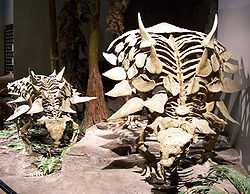Polacanthinae
| Polacanthines Temporal range: Late Jurassic - Early Cretaceous, 155–125Ma | |
|---|---|
 | |
| Skeletons of Gastonia burgei, North American Museum of Ancient Life | |
| Scientific classification | |
| Kingdom: | Animalia |
| Phylum: | Chordata |
| Clade: | Dinosauria |
| Order: | †Ornithischia |
| Suborder: | †Ankylosauria |
| Family: | †Nodosauridae |
| Subfamily: | †Polacanthinae Wieland, 1911 |
| Genera | |
| Synonyms | |
| |
Polacanthinae is a grouping of ankylosaurs, possibly primitive nodosaurids. Polacanthines are late Jurassic to early Cretaceous in age, and Kirkland observed they appeared to become extinct about the same time a land bridge opened between Asia and North America.[1]
Polacanthines were somewhat more lightly armoured than more advanced ankylosaurids and nodosaurids. Their spikes were made up of thin, compact bone with less reinforcing collagen than in the heavily armoured nodosaurids. The relative fragility of polacanthine armour suggests that it may have been as much for display as defense.[2]
Classification
The family Polacanthidae was named by Wieland in 1911 to refer to a group of ankylosaurs which seemed to him intermediate between the ankylosaurids and nodosaurids. This grouping was ignored by most researchers until the late 1990s, when it was used as a subfamily (Polacanthinae) by Kirkland for a natural group recovered by his 1998 analysis suggesting that Polacanthus, Gastonia, and Mymoorapelta were closely related within the family Ankylosauridae. Kenneth Carpenter resurrected the name Polacanthidae for a similar group which he also found to be closer to ankylosaurids than to nodosaurids. Carpenter became the first to define Polacanthidae as all dinosaurs closer to Gastonia than to either Edmontonia or Euoplocephalus.[3] Most subsequent researchers placed polacanthines as primitive ankylosaurids, though mostly without any rigorous study to demonstrate this idea. The first comprehensive study of 'polacanthid' relationships, published in 2012, found that they are either an unnatural grouping of primitive nodosaurids, or a valid subfamily at the base of Nodosauridae.[4]
References
- ↑ Kirkland, J. I. (1996). Biogeography of western North America's mid-Cretaceous faunas - losing European ties and the first great Asian-North American interchange. J. Vert. Paleontol. 16 (Suppl. to 3): 45A.
- ↑ Hayashi, S., Carpenter, K., Scheyer, T.M., Watabe, M. and Suzuki. D. (2010). "Function and evolution of ankylosaur dermal armor." Acta Palaeontologica Polonica, 55(2): 213-228. doi:10.4202/app.2009.0103
- ↑ Carpenter K (2001). "Phylogenetic analysis of the Ankylosauria". In Carpenter, Kenneth(ed). The Armored Dinosaurs. Indiana University Press. pp. 455–484. ISBN 0-253-33964-2.
- ↑ Thompson, R.S., Parish, J.C., Maidment, S.C.R. and Barrett, P.M. (2012). "Phylogeny of the ankylosaurian dinosaurs (Ornithischia: Thyreophora)." Journal of Systematic Palaeontology, 10(2): 301-312. doi:10.1080/14772019.2011.569091